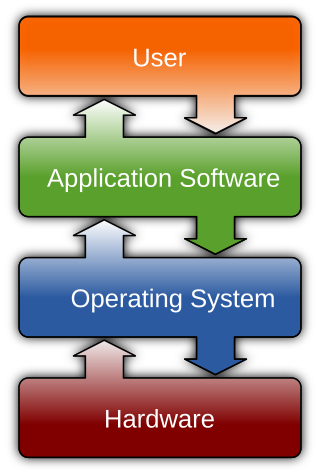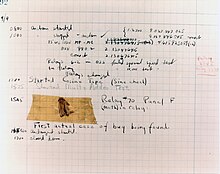
Software is a collection of programs and data that tell a computer how to perform specific tasks. Software often includes associated software documentation. This is in contrast to hardware, from which the system is built and which actually performs the work.
Computer programming or coding is the composition of sequences of instructions, called programs, that computers can follow to perform tasks. It involves designing and implementing algorithms, step-by-step specifications of procedures, by writing code in one or more programming languages. Programmers typically use high-level programming languages that are more easily intelligible to humans than machine code, which is directly executed by the central processing unit. Proficient programming usually requires expertise in several different subjects, including knowledge of the application domain, details of programming languages and generic code libraries, specialized algorithms, and formal logic.
In computer programming and software design, code refactoring is the process of restructuring existing computer code—changing the factoring—without changing its external behavior. Refactoring is intended to improve the design, structure, and/or implementation of the software, while preserving its functionality. Potential advantages of refactoring may include improved code readability and reduced complexity; these can improve the source code's maintainability and create a simpler, cleaner, or more expressive internal architecture or object model to improve extensibility. Another potential goal for refactoring is improved performance; software engineers face an ongoing challenge to write programs that perform faster or use less memory.
In computer science, static program analysis is the analysis of computer programs performed without executing them, in contrast with dynamic program analysis, which is performed on programs during their execution in the integrated environment.
A software bug is bug in computer software.

An embedded system is a computer system—a combination of a computer processor, computer memory, and input/output peripheral devices—that has a dedicated function within a larger mechanical or electronic system. It is embedded as part of a complete device often including electrical or electronic hardware and mechanical parts. Because an embedded system typically controls physical operations of the machine that it is embedded within, it often has real-time computing constraints. Embedded systems control many devices in common use. In 2009, it was estimated that ninety-eight percent of all microprocessors manufactured were used in embedded systems.

A debugger or debugging tool is a computer program used to test and debug other programs. The main use of a debugger is to run the target program under controlled conditions that permit the programmer to track its execution and monitor changes in computer resources that may indicate malfunctioning code. Typical debugging facilities include the ability to run or halt the target program at specific points, display the contents of memory, CPU registers or storage devices, and modify memory or register contents in order to enter selected test data that might be a cause of faulty program execution.
In-circuit emulation (ICE) is the use of a hardware device or in-circuit emulator used to debug the software of an embedded system. It operates by using a processor with the additional ability to support debugging operations, as well as to carry out the main function of the system. Particularly for older systems, with limited processors, this usually involved replacing the processor temporarily with a hardware emulator: a more powerful although more expensive version. It was historically in the form of bond-out processor which has many internal signals brought out for the purpose of debugging. These signals provide information about the state of the processor.
A programming tool or software development tool is a computer program that software developers use to create, debug, maintain, or otherwise support other programs and applications. The term usually refers to relatively simple programs, that can be combined to accomplish a task, much as one might use multiple hands to fix a physical object. The most basic tools are a source code editor and a compiler or interpreter, which are used ubiquitously and continuously. Other tools are used more or less depending on the language, development methodology, and individual engineer, often used for a discrete task, like a debugger or profiler. Tools may be discrete programs, executed separately – often from the command line – or may be parts of a single large program, called an integrated development environment (IDE). In many cases, particularly for simpler use, simple ad hoc techniques are used instead of a tool, such as print debugging instead of using a debugger, manual timing instead of a profiler, or tracking bugs in a text file or spreadsheet instead of a bug tracking system.
In programming and software development, fuzzing or fuzz testing is an automated software testing technique that involves providing invalid, unexpected, or random data as inputs to a computer program. The program is then monitored for exceptions such as crashes, failing built-in code assertions, or potential memory leaks. Typically, fuzzers are used to test programs that take structured inputs. This structure is specified, e.g., in a file format or protocol and distinguishes valid from invalid input. An effective fuzzer generates semi-valid inputs that are "valid enough" in that they are not directly rejected by the parser, but do create unexpected behaviors deeper in the program and are "invalid enough" to expose corner cases that have not been properly dealt with.
In software engineering, profiling is a form of dynamic program analysis that measures, for example, the space (memory) or time complexity of a program, the usage of particular instructions, or the frequency and duration of function calls. Most commonly, profiling information serves to aid program optimization, and more specifically, performance engineering.
Software visualization or software visualisation refers to the visualization of information of and related to software systems—either the architecture of its source code or metrics of their runtime behavior—and their development process by means of static, interactive or animated 2-D or 3-D visual representations of their structure, execution, behavior, and evolution.
An instruction set simulator (ISS) is a simulation model, usually coded in a high-level programming language, which mimics the behavior of a mainframe or microprocessor by "reading" instructions and maintaining internal variables which represent the processor's registers.
In computer programming jargon, a heisenbug is a software bug that seems to disappear or alter its behavior when one attempts to study it. The term is a pun on the name of Werner Heisenberg, the physicist who first asserted the observer effect of quantum mechanics, which states that the act of observing a system inevitably alters its state. In electronics, the traditional term is probe effect, where attaching a test probe to a device changes its behavior.
Dynamic program analysis is the act of analyzing software that involves executing a program – as opposed to static program analysis, which does not execute it.
Tracing in software engineering refers to the process of capturing and recording information about the execution of a software program. This information is typically used by programmers for debugging purposes, and additionally, depending on the type and detail of information contained in a trace log, by experienced system administrators or technical-support personnel and by software monitoring tools to diagnose common problems with software. Tracing is a cross-cutting concern.
Memory safety is the state of being protected from various software bugs and security vulnerabilities when dealing with memory access, such as buffer overflows and dangling pointers. For example, Java is said to be memory-safe because its runtime error detection checks array bounds and pointer dereferences. In contrast, C and C++ allow arbitrary pointer arithmetic with pointers implemented as direct memory addresses with no provision for bounds checking, and thus are potentially memory-unsafe.
Program animation or stepping refers to the debugging method of executing code one instruction or line at a time. The programmer may examine the state of the program, machine, and related data before and after execution of a particular line of code. This allows the programmer to evaluate the effects of each statement or instruction in isolation, and thereby gain insight into the behavior of the executing program. Nearly all modern IDEs and debuggers support this mode of execution.
Software archaeology or source code archeology is the study of poorly documented or undocumented legacy software implementations, as part of software maintenance. Software archaeology, named by analogy with archaeology, includes the reverse engineering of software modules, and the application of a variety of tools and processes for extracting and understanding program structure and recovering design information. Software archaeology may reveal dysfunctional team processes which have produced poorly designed or even unused software modules, and in some cases deliberately obfuscatory code may be found. The term has been in use for decades.
Automatic bug-fixing is the automatic repair of software bugs without the intervention of a human programmer. It is also commonly referred to as automatic patch generation, automatic bug repair, or automatic program repair. The typical goal of such techniques is to automatically generate correct patches to eliminate bugs in software programs without causing software regression.




